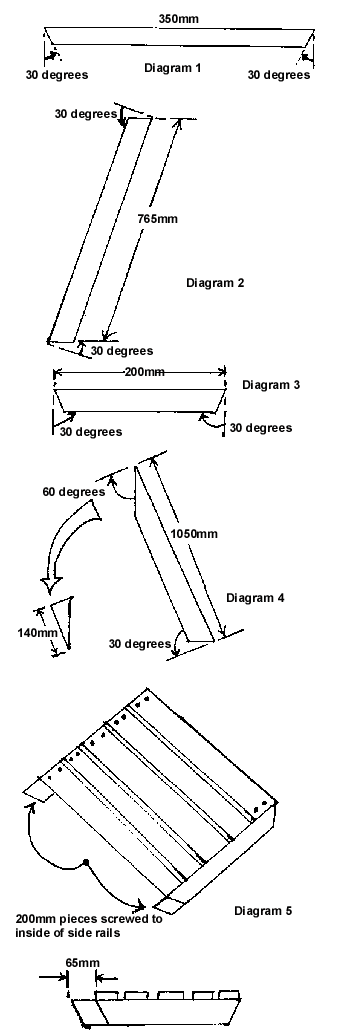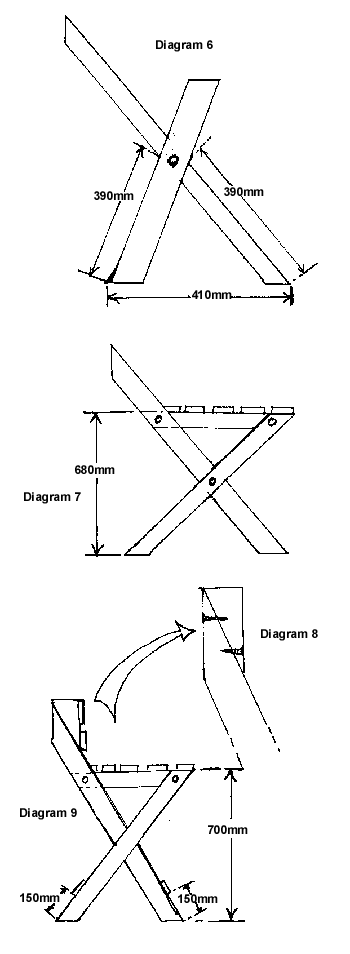
| Folding Bar Stool |
| Knock up a great-looking bar stool that can be used in a variety of locations around the house. |
|
|
 |
|
|
![]() This bar stool can be folded up and hidden away when not
needed. Once you know how to make one, it's easy to make a whole set for the bar
or kitchen bench. We've used a simple but contemporary design incorporating
tallow decking wood. The natural oils make this material very strong and
durable, as well as good-looking.
This bar stool can be folded up and hidden away when not
needed. Once you know how to make one, it's easy to make a whole set for the bar
or kitchen bench. We've used a simple but contemporary design incorporating
tallow decking wood. The natural oils make this material very strong and
durable, as well as good-looking.
1
Start by cutting wood as follows. With the 3.9m length, cut 8 @ 420mm long
pieces and 1 @ 460mm. All but one of the 8 pieces of 420mm will become the slats
for the seat and the backrest. The one left will become the front foot support.
The 460mm piece will be the support for the lower rear legs.
2
Next, cut the side rails out of the 3m length. You will need 2 @ 350mm. They
need to have a bevel of 30 degrees cut at each end. (See Diagram 1.)
3
The front legs are then cut from the remainder of the 3m piece, i.e. 2 @ 765mm
lengths. Again, a bevel cut of 30 degrees is cut on both pieces as before.
(See Diagram 2.) From the same 3m piece, cut off 200mm and bevel the ends as
before to a 30-degree angle.
4
Now, from the 2.4m length, cut 2 x 1050mm lengths. These will be the back legs.
At one end of both pieces, cut in 60-degree angles, starting 140mm down the
wood. The triangular offcuts will become part of the backrest. At the other
ends, cut in 30-degree angles. (See Diagram 4.)
5
For the assembly, use the 2 side rails and 5 x 420mm slats. Fix the slats evenly
apart between the 2 rails and secure in place with 2 screws for each slat. Using
the 2 x 200mm offcuts, screw them to the inside of the side rails so that they
overhang the edge by 65mm. (See Diagram 5.)
6
The legs are assembled by placing the front leg flat on a bench and crossing the
back leg over the front ones. Mark out the screw position by measuring 390mm up
the short pieces - this will be where the edge of the longer, front legs will
start. Drill a 1/4-inch hole and fit a 50mm gutter bolt, washer and locknut.
(See Diagram 6.) Note that the short legs (back legs) are bolted to the outside
of the longer pieces.
7
After assembling both sides for the legs, you can bolt the seat to the front.
(See Diagram 7.) To work out the height of the seat, measure 680mm from the
ground up, for the back of the seat. Drill a 1/4-inch hole and fit a 50mm gutter
bolt, washer and locknut.
Make sure the front edge of the seat lines up with the forward edge of the front
legs. Again, drill a 1/4-inch hole and fit a 50mm gutter bolt, washer and
locknut. (You can use a wing nut for this bolt, if you wish, for ease and speed
of folding).
8
Now it's time to fix the small wedge-shaped piece to the backrest of the stool.
Drill and screw the wedge onto the top of the back legs so that they sit flush
with the legs and create a straight line for your back to rest on. Use one screw
at the top from behind the seat and one from the front at the bottom. (See
Diagram 8.)
9
Screw the two backrest slats on so that they sit flush with the top and bottom
of the wedge that you have just attached. Next, make the cross members, one of
which will act as the footrest at the front. The 420mm piece goes on the front
legs, 150mm up from the bottom. The 460mm piece goes on across the back legs,
150mm up from the floor, as well. Sit the stool on a flat surface while
measuring. (See Diagram 9.)
Stain as desired, but remember to use an outdoor varnish if you are planning to
use the stool outside. In this example, a clear varnish was used.


Materials
Saw
Drill with a 1/8-inch bit, 1/4-inch bit and countersink bit
Sliding bevel and protractor
Tape measure and pencil
65mm x 20mm tallow hardwood decking:
1 @ 3.9m, 1 @ 3.0m, 1 @ 2.4m
50 x 50mm chipboard screws or similar
6 x 50mm x 1/4-inch gutter bolts, plus washers and locknuts